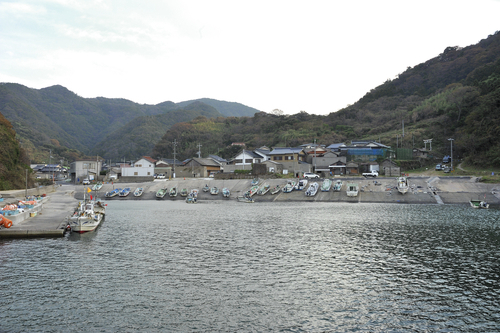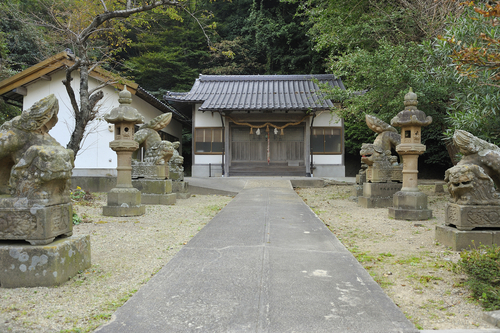saka-ura
| Bay Name | saka-ura | |
|---|---|---|
| Shrine Name | tomosaki-jinja | |
| Deity |
Susanoo no kami Amaterasu Oomikami |
|
| Location |
|

There are different ways to write this place name in terms of Japanese characters, but all of them are read as ‘saka’. We need to turn to the Izumo Fudoki for the origin of this word as a location. It first appears as ‘Saka-hama’ (shore) along with the account that huge numbers of kami gathered together there, built a brewery, and made rice wine in the river valley of Saka. When written with a different character, Saka also means ‘alcohol’ (found in the phrases for ‘merry making’, ‘sake shop’ and the surname/location ‘Sakata’) so the connection to the previous account can be seen. In addition, saka is also the reading for the words ‘hill’ ‘border’ ‘prosperity’ and the Sakaki tree sacred to Shintoism. This process of connections finally leads to the word ‘sakai’. When a person drinks ‘sake’, they become intoxicated and cross over a border ‘sakai’ and lose their way in an unearthly state ‘the world of the kami’. It’s also worth noting that Saka’s location is on the border between the provinces of Akika and Tatenui. Saka-ura becomes the bay of Saka-province. Tomosaki-no yashiro shrine can be seen in the Fudoki but in the Unyoushi written in the early modern period, it’s referred to as ‘Hinomisaki Daimyoujin’. It would seem the name of ancient times had been completely forgotten about at this point. Tomosaki-jinja got its name in the 4th year of the Meiji Period (1871). The question is whether the ancient Tomosaki-no-yashiro, the early modern Hinomisaki and today’s Tomosaki-jinja are all connected. According to the official shrine history, long ago there was a large mass of rock in the sea which housed the main shrine hall and the prayer hall. Here, worshippers gathered sea water and seaweed and adorned the pine tree that was also said to be there. After the shrine hall was washed away by strong waves, the shrine merged with Hinomisaki Daimyoujin. It’s a complex history for sure. It’s said that if one looks down from the shrine grounds of Tomosaki-jinja to the inlet of Saka Bay, one can see that in days gone by the inlet appears to have been shaped like the circular wrist protector as used by an archer. This device is called a ‘tomo’, written with the same character used in Tomosaki. In recent times, the coast has been rebuilt and reshaped so it’s not very easy to make out this image anymore. That circular shaped inlet (Tomo) could be said to have been pushed forward (saki) from the land where the shrine is today which certainly points to the ongoing transition of this shrine from ancient to modern times. The fragments of coral reef offered at a smaller shrine within the grounds of Tomosaki-jinja leave a lasting impression.

The Tondo Festival of Tomosaki Jinja celebrates the New Year using the Sacred Tree and 7 Gods of Fortune. The storage room to the left of the shrine has an O-mikoshi (portable shrine) decorated with the 7 Gods and the Palace of the Dragon King. The 7 gods are dressed in kimono and are prayed to for this year’s health, bumper harvest and great fish haul. In the evening of the 3rd, the previous year’s gratitudes are collected and burned during the ‘firewalking ceremony’ and other events. Next, duties are paid to prevent misfortune in the forthcoming year by writing wishes on a human shaped figure. If it is sent to Tomosaki jinja by December 20th, it can make up part of the exorcism of bad spirits ceremony (the Ooharai-sai)on the December 30th. Apparently many requests come from those living outside the town creating a nostalgic custom. In Saka-ura port there is an old road used by pilgrims that heads towards Aka-ura, it is the location where Honzon -Yakushi Nyourai appeared and is related to the foundation of Ichibata Yakushi Temple.
Walking to Aka-ura via the mountain on the West side of the port gives you a view of the Sea of Japan en route and will take about 30 minutes. The journey by boat from Saka-ura port will be around 15 minutes.
| Bay Name | saka-ura | |
|---|---|---|
| Shrine Name | tomosaki-jinja | |
| Deity |
Susanoo no kami Amaterasu Oomikami |
|
| Location |
|
There are different ways to write this place name in terms of Japanese characters, but all of them are read as ‘saka’. We need to turn to the Izumo Fudoki for the origin of this word as a location. It first appears as ‘Saka-hama’ (shore) along with the account that huge numbers of kami gathered together there, built a brewery, and made rice wine in the river valley of Saka. When written with a different character, Saka also means ‘alcohol’ (found in the phrases for ‘merry making’, ‘sake shop’ and the surname/location ‘Sakata’) so the connection to the previous account can be seen. In addition, saka is also the reading for the words ‘hill’ ‘border’ ‘prosperity’ and the Sakaki tree sacred to Shintoism. This process of connections finally leads to the word ‘sakai’. When a person drinks ‘sake’, they become intoxicated and cross over a border ‘sakai’ and lose their way in an unearthly state ‘the world of the kami’. It’s also worth noting that Saka’s location is on the border between the provinces of Akika and Tatenui. Saka-ura becomes the bay of Saka-province. Tomosaki-no yashiro shrine can be seen in the Fudoki but in the Unyoushi written in the early modern period, it’s referred to as ‘Hinomisaki Daimyoujin’. It would seem the name of ancient times had been completely forgotten about at this point. Tomosaki-jinja got its name in the 4th year of the Meiji Period (1871). The question is whether the ancient Tomosaki-no-yashiro, the early modern Hinomisaki and today’s Tomosaki-jinja are all connected. According to the official shrine history, long ago there was a large mass of rock in the sea which housed the main shrine hall and the prayer hall. Here, worshippers gathered sea water and seaweed and adorned the pine tree that was also said to be there. After the shrine hall was washed away by strong waves, the shrine merged with Hinomisaki Daimyoujin. It’s a complex history for sure. It’s said that if one looks down from the shrine grounds of Tomosaki-jinja to the inlet of Saka Bay, one can see that in days gone by the inlet appears to have been shaped like the circular wrist protector as used by an archer. This device is called a ‘tomo’, written with the same character used in Tomosaki. In recent times, the coast has been rebuilt and reshaped so it’s not very easy to make out this image anymore. That circular shaped inlet (Tomo) could be said to have been pushed forward (saki) from the land where the shrine is today which certainly points to the ongoing transition of this shrine from ancient to modern times. The fragments of coral reef offered at a smaller shrine within the grounds of Tomosaki-jinja leave a lasting impression.
The Tondo Festival of Tomosaki Jinja celebrates the New Year using the Sacred Tree and 7 Gods of Fortune. The storage room to the left of the shrine has an O-mikoshi (portable shrine) decorated with the 7 Gods and the Palace of the Dragon King. The 7 gods are dressed in kimono and are prayed to for this year’s health, bumper harvest and great fish haul. In the evening of the 3rd, the previous year’s gratitudes are collected and burned during the ‘firewalking ceremony’ and other events. Next, duties are paid to prevent misfortune in the forthcoming year by writing wishes on a human shaped figure. If it is sent to Tomosaki jinja by December 20th, it can make up part of the exorcism of bad spirits ceremony (the Ooharai-sai)on the December 30th. Apparently many requests come from those living outside the town creating a nostalgic custom. In Saka-ura port there is an old road used by pilgrims that heads towards Aka-ura, it is the location where Honzon -Yakushi Nyourai appeared and is related to the foundation of Ichibata Yakushi Temple.
Walking to Aka-ura via the mountain on the West side of the port gives you a view of the Sea of Japan en route and will take about 30 minutes. The journey by boat from Saka-ura port will be around 15 minutes.






